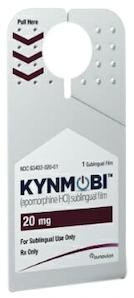Kynmobi Dosage
Generic name: apomorphine hydrochloride 10mg
Dosage form: sublingual film, soluble
Drug class: Dopaminergic antiparkinsonism agents
Medically reviewed by Drugs.com. Last updated on Jun 11, 2025.
Important Administration Instructions
KYNMOBI is for sublingual administration only.
Dose initiation should be supervised by a healthcare provider.
KYNMOBI must be administered whole. Do not cut, chew, or swallow KYNMOBI. KYNMOBI will disintegrate in about 3 minutes.
Premedication and Concomitant Medication Considerations
Because of the incidence of nausea and vomiting experienced by patients taking KYNMOBI at recommended doses, treatment with the antiemetic trimethobenzamide 300 mg three times a day may be administered as needed, prior to, or during treatment with KYNMOBI. If pretreatment for nausea or vomiting is considered, trimethobenzamide may be started 3 days prior to the initial dose of KYNMOBI. Treatment with trimethobenzamide should only be continued as long as necessary and generally no longer than 2 months.
Based on reports of profound hypotension and loss of consciousness when apomorphine was administered with ondansetron, the concomitant use of apomorphine with drugs of the 5HT3 antagonist class including antiemetics (for example, ondansetron, granisetron, dolasetron, palonosetron) and alosetron are contraindicated.
Dosing Information
The dose range for KYNMOBI is 10 mg to 30 mg per dose, administered sublingually, as needed, for the acute, intermittent treatment of “off” episodes.
Doses should be separated by at least 2 hours. If a single dose of KYNMOBI is ineffective for a particular “off” episode, a second dose should not be given for that “off” episode. The efficacy or safety of administering a second dose for a single “off” episode has not been studied.
Do not administer more than 5 doses per day.
The maximum single dose of KYNMOBI is 30 mg.
Dose Titration
The initial dose is 10 mg. Dose initiation should occur when the patient is in an “off” state and in a setting where a healthcare provider can monitor blood pressure and pulse. In clinical studies of KYNMOBI, the “off” state was achieved by instructing patients to not take their regular morning dose of carbidopa/levodopa or any other adjunctive Parkinson's disease medications, and to take their last dose of carbidopa/levodopa and any other adjunctive Parkinson's disease medications no later than midnight the night before.
If the patient tolerates the 10 mg dose, and responds adequately, the starting dose should be 10 mg, used on an as-needed basis, up to 5 times per day, to treat “off” episodes. If the dose is tolerated but the response is insufficient, the patient's usual Parkinson's disease medications should be resumed and up-titration with KYNMOBI continued generally within 3 days. Increase dosage by increments of 5 mg and assess response. Continue to titrate in a similar manner, under the supervision of a healthcare provider, until an effective and tolerable dose is achieved.
More about Kynmobi (apomorphine)
- Check interactions
- Compare alternatives
- Drug images
- Side effects
- During pregnancy
- FDA approval history
- Drug class: dopaminergic antiparkinsonism agents
- Breastfeeding
Patient resources
Other brands
Professional resources
Other brands
Related treatment guides
See also:
Further information
Always consult your healthcare provider to ensure the information displayed on this page applies to your personal circumstances.


